Modeling and Simulation
Vol.
11
No.
01
(
2022
), Article ID:
47960
,
12
pages
10.12677/MOS.2022.111011
线性压缩机中间隙密封泄漏的微观机理研究
韩树康,胡玉莹,陈相,胡均瑶,叶梅笑寒,祁影霞*
上海理工大学能源与动力工程学院,上海
收稿日期:2021年11月20日;录用日期:2022年1月8日;发布日期:2022年1月14日

摘要
线性压缩机内部的活塞与气缸内壁面之间存在间隙,而间隙的厚度对压缩机运行效率影响甚大。间隙过小会导致磨损的可能,减少压缩机使用寿命;间隙过大又起不到密封工作流体的作用,造成相当一部分损失。基于分子动力学方法,建立了线性压缩机的物理模型,研究了线性压缩机在做正弦交变运动时,活塞运行频率、活塞行程、间隙宽度及间隙长度对间隙密封泄漏的影响关系。研究发现:泄漏量随频率和行程的增大而减小,且两者都使压缩机压比增大。在气缸总尺寸不变时,活塞宽度减小即间隙宽度增加时,泄漏量增大,压比以平方关系下降;活塞长度增加时即间隙密封长度增大,但是泄漏量和压缩机压比几乎没有变化。研究表明间隙宽度及活塞行程对泄漏量影响较大。
关键词
分子动力学,交变振荡,间隙密封,线性压缩机

Research on Microscale Mechanism of Clearance Seal Leakage in Linear Compressor
Shukang Han, Yuying Hu, Xiang Chen, Junyao Hu, Meixiaohan Ye, Yingxia Qi*
School of Energy and Power Engineering, University of Shanghai for Science and Technology, Shanghai
Received: Nov. 20th, 2021; accepted: Jan. 8th, 2022; published: Jan. 14th, 2022

ABSTRACT
There is a gap between the piston inside the linear compressor and the inner wall of the cylinder, and the thickness of the gap has a great influence on the operating efficiency of the compressor. If the gap is too small, it will lead to the possibility of wear and reduce the service life of the compressor; if the gap is too large, it will not be able to seal the working fluid, causing a considerable part of the loss. Based on the molecular dynamics method, the physical model of the linear compressor is established, and the influence of the piston operating frequency, piston stroke, gap width and gap length on the leakage of the gap seal is studied when the linear compressor performs sinusoidal alternating motion. It is found that the leakage decreases with the increase of frequency and stroke, and both increase the compressor pressure ratio. When the total size of the cylinder remains the same, when the width of the piston decreases, that is, when the width of the gap increases, the leakage increases, and the pressure ratio decreases in a square relationship; when the length of the piston increases, the length of the gap seal increases, but the leakage and the compressor pressure ratio are almost the same. The research shows that the gap width and piston stroke have a great influence on the leakage.
Keywords:Molecular Dynamics, Alternating Oscillation, Gap Seal, Linear Compressor

Copyright © 2022 by author(s) and Hans Publishers Inc.
This work is licensed under the Creative Commons Attribution International License (CC BY 4.0).
http://creativecommons.org/licenses/by/4.0/


1. 引言
线性压缩机与传统压缩机相比,是一种非常有吸引力的蒸汽压缩技术,因为它不需要曲柄机构且结构紧凑,极大地减少了摩擦,具有高电机效率、谐振操作、小尺寸和简单的容量调节 [1] [2] [3] [4]。线性压缩机将电磁力转化为活塞往复运动的驱动力,活塞运动方向平行于气缸,没有活塞与气缸之间侧向力的作用 [5] [6] [7],因此实现压缩机的振动减少、噪音降低、寿命提高的优点。线性压缩机中的活塞与气缸壁之间存在微小的间隙,间隙密封厚度的确定对特定线性压缩机的效率至关重要。如果间隙太大,工作流体的泄漏会带来相当大的损失,甚至导致间隙密封的失效 [8] [9] [10] [11]。然而,如果间隙过小,活塞和气缸之间将有间歇接触和磨损的可能性,特别是当工作温度变化或在空间应用中典型的环境振动下。目前这个尺寸是小于20 μm,间隙在压缩机运行时起到密封作用,换句话说,间隙实际上充当系统中工作流体的动态密封 [12]。尽管间隙小但仍存在质量流经间隙由压缩腔往背压腔泄漏的现象,使活塞两端形成一定的压差,压差在一定程度上会造成压缩机活塞的偏置。因此研究线性压缩机间隙密封的质量流泄漏是非常有必要的,在线性压缩机间隙泄漏的减小或者消除方面提供一定的理论参考。
马诗旻 [13] 采用数值模拟的方法,对自由活塞式斯特林制冷机压缩活塞与气缸的间隙密封内氦气建立数值模型,模拟了间隙内氦气在不同工况下的层流流动。分析结果显示压力波和间隙宽度对泄漏量的影响较大,随充气压力、压比以及间隙的增大,泄漏量增加;活塞运动对其影响较小,当活塞位移波与压力波的相位差小于90˚时,相位差增大,泄漏量增加,活塞频率增大,泄漏量增加。Kun Liang [14] 等人设计并制造了一种具有间隙密封和挠性轴承的新型动磁直线压缩机,并将线性压缩机损失分为电机损失和热力损失两项。热力损失源于密封泄漏、热传递(在压缩过程中流出,在膨胀过程中流入)和阀门两侧的压降。通过实验得到线性压缩机的密封泄漏损失占5%。Xinye Zhang [15] 等人提到有两种方法可以解决无油线性压缩机中的泄漏和摩擦问题。一种是使用高压回流气体作为气体轴承,以密封泄漏,同时减少摩擦损失;另一种方法是设计具有额外长度的活塞,形成泄漏路径中的阻塞流,可以减少泄漏的质量流。
本文采用分子动力学方法,研究了线性压缩机活塞在做正弦交变运动时,活塞与气缸之间的间隙中的泄漏过程,及压缩机频率、活塞行程、间隙宽度及间隙长度对间隙密封泄漏量的影响关系。
2. 物理模型
为了研究线性压缩机的各个参数对其泄露量的影响,建立了如图1所示的线性压缩机模型。将整个模型简化为平板型的微通道 [16]。整个模型由背压腔、活塞、压缩腔和密封间隙组成,模型总尺寸为14.303Å × 1350Å × 7030Å即1.4 nm × 130 nm × 703 nm (X × Y × Z),背压腔体积(56,108.24 nm3)与压缩腔体积(37,386.83 nm3)比为3:2,活塞外部框架由Fe原子壁面组成,活塞内部为真空状态,其余部分充满He,在模拟过程中X边界上设置为周期性边界条件,Y和Z设置为虚拟反弹边界条件。活塞的位移曲线为正弦函数,其初始方向为正,活塞在Z轴上的运动曲线如公式(1)所示:
(1)
式中: 为压缩活塞的振幅; 为角速度,在数值上等于 ; 为活塞的实时运动时间; 是初始运动时间,本文 , 是时间步长,取0.4 fs; 为周期,为400~600 ps。
各工况在NVE系综(原子数、模型体积、总能量)下运行 步,3200 ps获得用于分析的数据。
图1. 模型结构示意图
3. 模拟结果及分析
活塞运动示意图如图2所示,在一个周期内,活塞在前半周期运动方向为正,在后半周期运动方向为负,周期结束时回到初始点,完成一个循环。以下所示是四个周期的示意图。
图2. 在4个周期内活塞运动模拟结果
3.1. 活塞位移与压力波相位
模型的初始参数为初始压力P0 = 2.5 MPa、T0 = 300 K、间隙宽度δ = 150 Å、间隙长度l = 2000 Å、活塞行程Z = 500 Å、频率400 ps。根据控制变量的方法研究不同参数对间隙泄漏的影响,当某一参数变化时,其余参数不变。本文定义气体流向Z轴正方向(压缩腔方向)时质量流为正,反之为负。
图3为活塞位移与背压腔压力波相位关系,两者刚好呈反向关系。
图3. 活塞位移波与压力波相位曲线
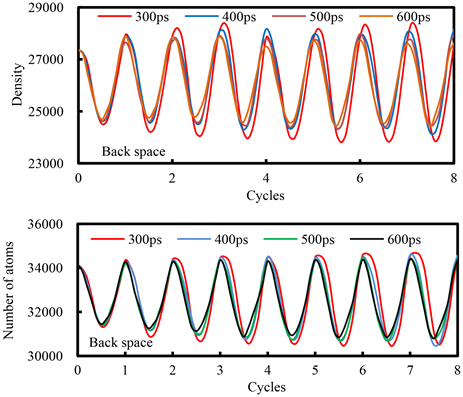
Figure 4. Instantaneous change of the number of atoms in the back cavity at different frequencies
图4. 不同频率下背压腔中原子数的瞬时变化
3.2. 活塞频率及行程对泄漏量的影响
图4~6为不同运行周期时背压腔、压缩腔和间隙中原子数随运行时间的周期性变化。在体积相同时,原子数也可以确定,因此固定体系的原子数与密度和压力成正比,所以原子数的变化也可以看成是密度、压力的变化。可以看出,随着运行周期的延长,即频率的降低,背压腔、压缩腔、间隙中的曲线的振幅均有所减小,即压比减小;说明频率增大可以提高压比。图7是压比随运行频率的变化,可知频率越高,压比越大,压比与周期的关系近似符合二次曲线关系。图8是图4、图5中的原子数的时间平均值。可以看出,背压腔、压缩腔均存在最大或最小时均密度。在300 ps时,背压腔和压缩腔中分别具有最小和最大密度,即极高频时,泄漏分子数较少。在400~600 ps之间,则背压腔时均密度随频率增大而增大,即泄漏增大。总的来说,周期越短,频率越高,泄漏越小,压比也越大。
图9~11为不同活塞行程时背压腔、压缩腔、间隙中原子数随时间的周期变化。可以看出,随着活塞行程的增大,背压腔中曲线波谷向下移动,即平均密度降低,压缩腔和间隙中曲线波峰向上移动,同时振荡曲线的波峰与波谷的差值在增大,即压比在增大。图12是压比随活塞行程的变化,可知行程越大,压比越大,压比与活塞行程的关系近似符合二次曲线关系。图13是图9~11中的曲线的时均值随行程的变化,可以看出,行程越大,背压腔中的原子密度越低,压缩腔和间隙中的原子密度越高,泄漏越小。
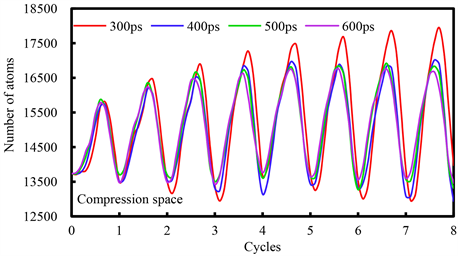
Figure 5. Instantaneous change of the number of atoms in a compressed cavity at different frequencies
图5. 不同频率下压缩腔中原子数的瞬时变化
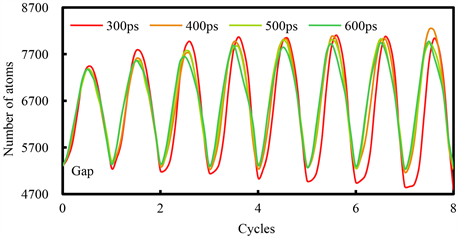
Figure 6. The instantaneous change of the number of atoms in the gap at different frequencies
图6. 不同频率下间隙中原子数的瞬时变化
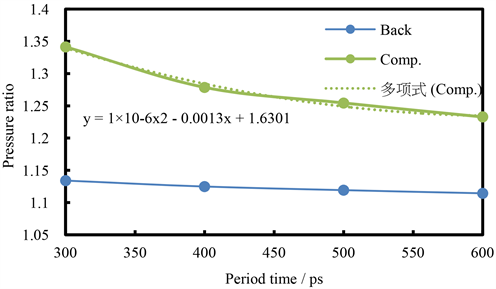
Figure 7. Change of pressure ratio with operating frequency
图7. 压比随运行频率的变化
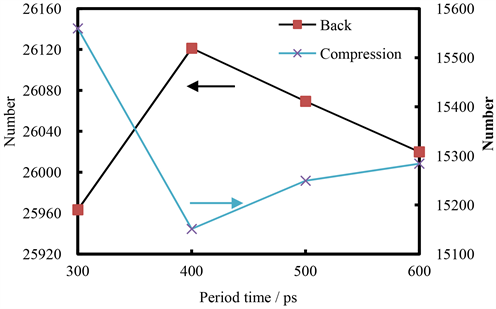
Figure 8. Time-average atomic number density changes with period length
图8. 时均原子数密度随周期时长的变化
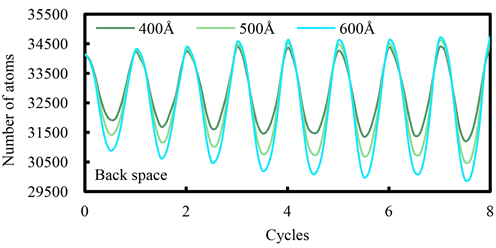
Figure 9. Instantaneous change of atomic number in the back pressure cavity under different piston strokes
图9. 不同活塞行程下背压腔中原子数的瞬时变化
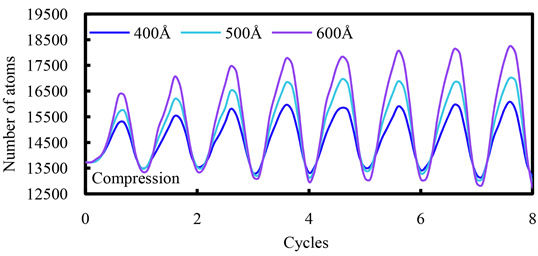
Figure 10. Instantaneous change of the number of atoms in the compression chamber under different piston strokes
图10. 不同活塞行程下压缩腔中原子数的瞬时变化

Figure 11. The instantaneous change of the number of atoms in the gap under different piston strokes
图11. 不同活塞行程下间隙中原子数的瞬时变化
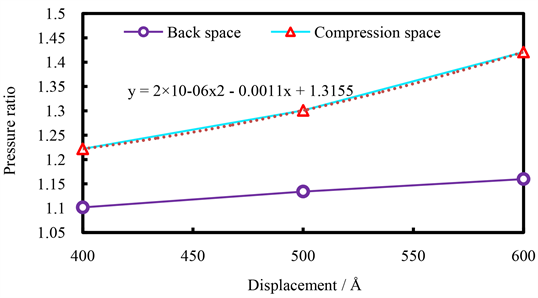
Figure 12. Change of pressure ratio with piston stroke
图12. 压比随活塞行程的变化
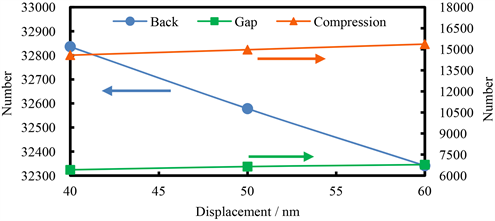
Figure 13. The number of atoms in the back pressure cavity, compression cavity, and gap changes with stroke
图13. 背压腔、压缩腔、间隙中原子数随行程的变化

Figure 14. Instantaneous change of the number of atoms in the back pressure cavity under different gap widths
图14. 不同间隙宽度下背压腔中原子数的瞬时变化

Figure 15. Instantaneous change of the number of atoms in a compressed cavity under different gap widths
图15. 不同间隙宽度下压缩腔中原子数的瞬时变化
3.3. 间隙宽度及长度对泄漏量的影响
模型的Y轴和Z轴方向长度不发生改变,通过改变活塞的宽度和长度进而改变间隙的宽度与长度,得到以下仿真结果。
图14、图15是背压腔、压缩腔中的原子数随时间的周期性变化。可以看出,随着间隙宽度的增加,背压腔中曲线波谷向上移动,平均密度增大,而压缩腔中曲线波峰向下移动,平均密度减小,同时振幅减小,压比减小。图16是间隙中原子数随时间的变化,图中的曲线进行了平移以具有相同的初始位置,可以看出,随着间隙宽度的增加,振幅减小。图17表明压比随间隙宽度的增大而减小,压比与间隙宽度的关系近似二次曲线关系。图18是图14、图15中原子数密度时均值随温度的变化,可以看出,随着间隙宽度的变宽,背压腔中密度逐渐增大,压缩腔和间隙中的密度缓慢下降,意味着泄漏量增大。

Figure 16. Instantaneous change of the number of atoms in the gap under different gap widths
图16. 不同间隙宽度下间隙中原子数的瞬时变化
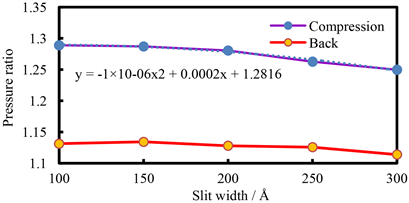
Figure 17. Change of pressure ratio with gap width
图17. 压比随间隙宽度的变化
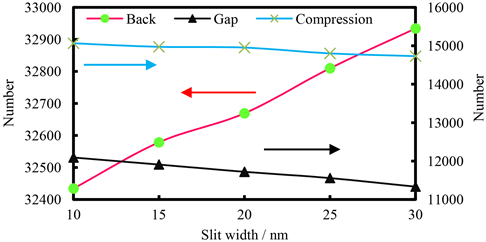
Figure 18. The change of atomic number density in back pressure cavity, compression cavity and gap with gap width
图18. 背压腔、压缩腔、间隙中原子数密度随间隙宽度的变化
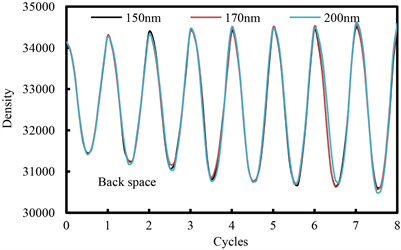
Figure 19. The instantaneous change of atomic number density in the back pressure cavity with different gap lengths
图19. 不同间隙长度时背压腔中原子数密度的瞬时变化

Figure 20. Instantaneous change of atomic number density in compressed cavity under different gap lengths
图20. 不同间隙长度下压缩腔中原子数密度的瞬时变化

Figure 21. The instantaneous change of the atomic number density in the gap under different gap lengths
图21. 不同间隙长度下间隙中原子数密度的瞬时变化
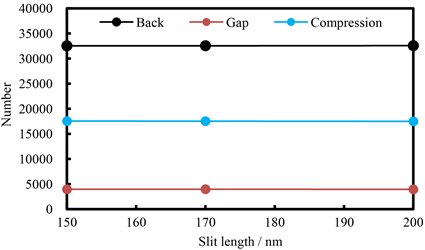
Figure 22. The change of atomic number density in back pressure cavity, compression cavity and gap with gap length
图22. 背压腔、压缩腔、间隙中原子数密度随间隙长度的变化
图19~21是不同间隙长度时背压腔、压缩腔和间隙中原子数密度的瞬时变化。可以看出,间隙长度对背压腔、压缩腔和间隙中的密度变化曲线几乎没有影响。因而可知压比也不随间隙长度而变化。图22是图19~21中背压腔、压缩腔、间隙中时均原子数密度随间隙长度的变化,可以看出,背压腔、压缩腔和密封间隙中的时均密度随间隙长度的变长几乎不发生变化。
4. 总结
本文基于分子动力学方法,研究了线性压缩机中气体在微通道内交变振荡下的间隙密封泄漏。活塞运行频率、活塞行程、间隙宽度和间隙长度对间隙密封泄漏量及压缩机性能有不同的影响,得出以下结论:泄漏随频率的增加而减小,压缩腔中压比随频率的增大而增大,且近似呈平方关系;行程的增大使泄漏率减小,且压缩腔中压比增大。在气缸总宽度不变时,随活塞宽度的减小、间隙密封宽度的增加,泄漏率增大,压缩机压比减小,压比随间隙宽度近似呈二次关系下降。活塞长度的增加即间隙密封长度的增加,泄漏率基本不变,且压比也保持不变。其中间隙宽度及活塞行程对泄漏量影响较大,并且存在最佳频率使泄漏量最小。本研究的模拟结果具有一定意义,对微观尺度下压缩机泄漏仿真模拟有一定的参考价值。
基金项目
上海市动力工程多相流动与传热重点实验室项目(No. 13DZ2260900)
国家重点研发计划(No. 2020YFF0303901)。
文章引用
韩树康,胡玉莹,陈 相,胡均瑶,叶梅笑寒,祁影霞. 线性压缩机中间隙密封泄漏的微观机理研究
Research on Microscale Mechanism of Clearance Seal Leakage in Linear Compressor[J]. 建模与仿真, 2022, 11(01): 124-135. https://doi.org/10.12677/MOS.2022.111011
参考文献
- 1. Jiang, H.Y., Liang, K., Li, Z.H., Zhu, Z.N., Zhi, X.Q. and Qiu, L.M. (2020) A Sensor-Less Stroke Detection Technique for Linear Refrigeration Compressors Using Artificial Neural Network. International Journal of Refrigeration, 114, 62-70. https://doi.org/10.1016/j.ijrefrig.2020.02.037
- 2. Chen, H.Y. Lv, Z.Q., Yang, X.W., Liu, X.Y. and Li, P.F. (2021) Characteristics of a Novel Cylindrical Arm Spiral Spring for Linear Compressor. International Journal of Refrig-eration, 131, 1000-1009. https://doi.org/10.1016/j.ijrefrig.2021.07.006
- 3. Liang, K.A. (2017) Review of Linear Compressors for Refrigeration. International Journal of Refrigeration, 84, 253-273. https://doi.org/10.1016/j.ijrefrig.2017.08.015
- 4. 谢洁飞, 金涛, 童水光. 直线压缩机的研究现状与发展趋势[J]. 流体机械, 2004, 32(12): 31-35.
- 5. 潘贤耀, 余水金. 节能新产品——电磁式空气压缩机[J]. 压缩机技术, 1993(3): 47-49.
- 6. Wei, Y.D., Zuo, Z.X., Jia, B.R., Feng, H.H. and Liang, K. (2020) Influence of Piston Displacement Profiles on the Performance of a Novel Dual Piston Linear Compressor. International Journal of Refrigeration, 117, 71-80. https://doi.org/10.1016/j.ijrefrig.2020.03.032
- 7. Bijanzad, A., Hassan, A. and Lazoglu, I. (2016) Analysis of Solenoid Based Linear Compressor for Household Refrigerator. International Journal of Refrigeration, 74, 116-128. https://doi.org/10.1016/j.ijrefrig.2016.10.015
- 8. 白绍竣, 张东风, 田大成, 等. 线性对置式压缩机非线性振动特性理论研究[J]. 低温与超导, 2020, 48(1): 12-16+22.
- 9. Hwang, I.S. and Lee, Y.L. (2019) Science-Mechanical Science; Reports Summarize Mechanical Science Study Results from Kongju National University (Study on Performance Change in a Linear Compressor Considering Refrigerant Leakage Through the Suction Valve Clearance). Journal of Technology, 33, 2665-2670.
- 10. Hwang, I.S. and Lee, Y.L. (2019) Study on Performance Change in a Linear Compressor Considering Refrigerant Leakage through the Suction Valve Clearance. Journal of Mechanical Science and Technology, 33, 2665-2670. https://doi.org/10.1007/s12206-019-0514-8
- 11. Liang, K., Stone, R., Dadd, M. and Bailey, P. (2016) The Effect of Clearance Control on the Performance of an Oil-Free Linear Refrigeration Compressor and a Comparison between Using a Bleed Flow and a DC Current Bias. International Journal of Refrigeration, 69, 407-417. https://doi.org/10.1016/j.ijrefrig.2016.06.006
- 12. Dang, H. (2015) Development of High Performance Moving-Coil Linear Compressors for Space Stirling-Type Pulse Tube Cryocoolers. Cryogenics, 68, 1-18. https://doi.org/10.1016/j.cryogenics.2015.01.009
- 13. 马诗旻, 陈曦, 李静, 等. 自由活塞式斯特林制冷机压缩活塞间隙密封泄漏的数值模拟[J]. 低温工程, 2011(3): 24-28.
- 14. Liang, K., Stone, R., Davies, G., et al. (2014) Modelling and Measurement of a Moving Magnet Linear Compressor Performance. Energy, 66, 487-495. https://doi.org/10.1016/j.energy.2014.01.035
- 15. Zhang, X., Ziviani, D., Braun, J.E., et al. (2020) Theoretical Analysis of Dynamic Characteristics in Linear Compressors. International Journal of Refrigeration, 109, 114-127. https://doi.org/10.1016/j.ijrefrig.2019.09.015
- 16. 李诚展, 李建国, 孙建, 等. 无油线性压缩机的频率特性和活塞偏移特性研究[J]. 振动与冲击, 2021, 40(3): 139-146.
NOTES
*通讯作者。